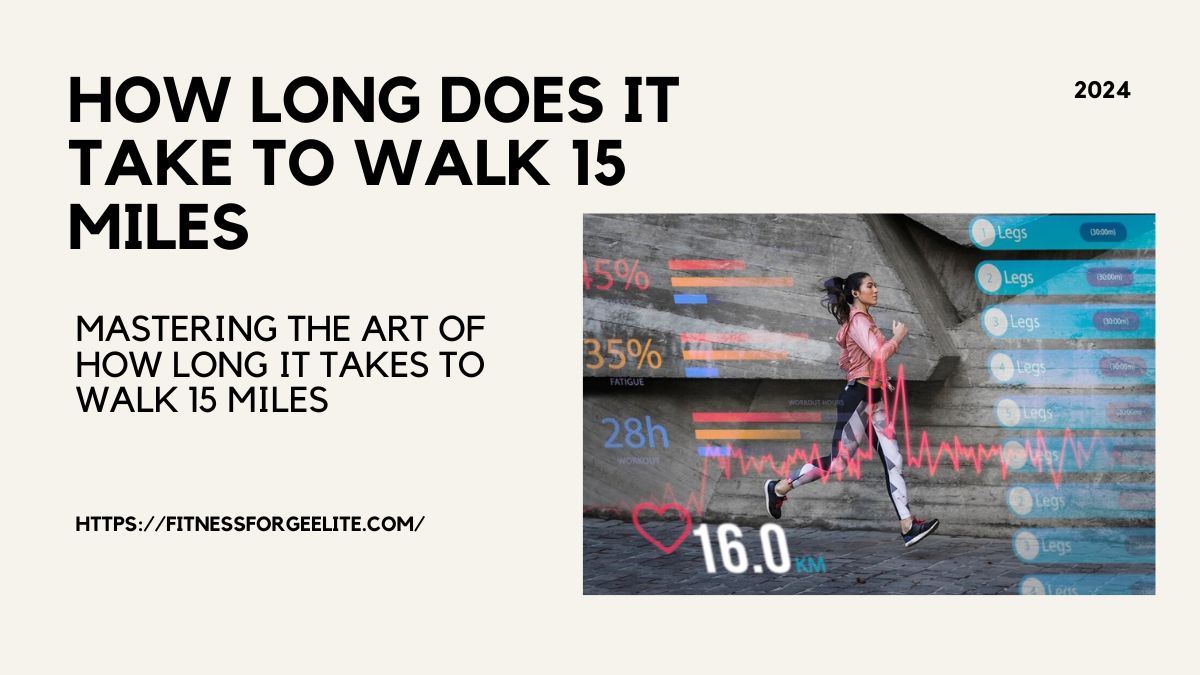How long it takes to walk 15 miles may sound daunting at first, but with the right preparation and mindset, it can become an exhilarating journey. Whether you’re a seasoned hiker or a casual walker looking to push your limits, understanding the factors that influence walking time is crucial. In this guide, we’ll delve into the intricacies of walking 15 miles, exploring average speeds, calculating walking times, real-life examples, and essential tips to make your journey smooth and enjoyable.
Factors Affecting Walking Speed
Terrain and Surface
The type of terrain you’re traversing plays a significant role in determining your walking speed. Walking on flat, paved surfaces like sidewalks or roads allows for faster and more consistent progress compared to uneven or rugged terrain such as trails or mountains. Uphill sections can significantly slow you down, while downhill stretches may allow for quicker movement but require caution to prevent injury.
Physical Fitness Level
Your physical fitness level directly impacts your walking speed and endurance. Individuals who engage in regular physical activity and maintain good cardiovascular health tend to walk faster and sustain their pace for longer durations. Conversely, those who are less active or have underlying health issues may find walking 15 miles more challenging and require additional breaks.
Read More: Unveiling the Mystery: How Long is 100 Miles?
Weather Conditions
Weather conditions can affect your walking speed and comfort. Hot and humid weather may lead to fatigue and dehydration, while cold temperatures can decrease muscle flexibility and increase the risk of injury. Additionally, wind and precipitation can impede progress and require extra effort to maintain pace. It’s essential to dress appropriately for the weather and stay hydrated throughout your walk.
Average Walking Speed
Definition of Average Walking Speed
Walking speed is typically measured in terms of distance covered over a specific period, often expressed in miles per hour (mph) or kilometers per hour (km/h). The average walking speed varies among individuals and is influenced by factors such as age, fitness level, terrain, and environmental conditions.
In general, the average walking speed for adults on flat, even terrain ranges from 3 to 4 miles per hour (4.8 to 6.4 kilometers per hour). However, this figure can vary significantly depending on individual characteristics and external factors.
General Estimation of Walking Speeds
While the average walking speed provides a baseline for estimation, it’s essential to recognize that walking speed can vary widely depending on the circumstances. Factors such as terrain, weather conditions, physical fitness level, and load carrying can all influence how quickly individuals progress.

For example, walking on flat, paved surfaces in favorable weather conditions may result in faster speeds, approaching or even exceeding the average range. Conversely, navigating through challenging terrain or adverse weather conditions may necessitate a slower pace to ensure safety and preserve energy.
How It Applies to Walking 15 Miles
When estimating walking time for a distance of 15 miles, it’s important to consider the average walking speed as a reference point while accounting for the various factors that can influence speed and endurance. By factoring in these variables, walkers can make more accurate predictions regarding their journey’s duration and plan accordingly.
For instance, if we consider an average walking speed of 3 miles per hour, it would take approximately 5 hours to cover a distance of 15 miles without factoring in breaks or rest stops. However, this estimate can vary based on individual circumstances and environmental conditions, requiring adjustments to account for the specific context of the journey.
Calculating Walking Time for 15 Miles
Simple Calculations Based on Average Walking Speeds
To calculate the walking time for a distance of 15 miles, one can use the average walking speed as a starting point and apply it to the given distance. Using the average walking speed of 3 miles per hour as an example, we can determine that it would take approximately 5 hours to walk 15 miles at this pace.
5 hours = 15 miles3 mph5 / hours=3 mph15 miles
This straightforward calculation provides a rough estimate of the walking time without factoring in breaks, rest stops, or adjustments for terrain and other variables.
Adjustments for Terrain, Fitness Level, and Other Factors
While the average walking speed provides a useful benchmark, it’s important to adjust this estimate to account for the specific conditions of the journey. Factors such as terrain, fitness level, weather conditions, and load carrying can all influence walking speed and endurance, necessitating adjustments to the initial calculation.
For example, walking on flat, even terrain may allow for faster speeds compared to navigating through rugged trails or steep inclines. Similarly, individuals with higher levels of fitness may maintain a brisker pace and require fewer breaks, resulting in shorter overall walking times.
Tools and Resources for More Accurate Estimations
Several tools and resources are available to help walkers plan their journeys and estimate walking times more accurately. Online calculators and mobile applications allow users to input various parameters such as distance, terrain, fitness level, and walking speed to generate customized predictions of walking time.
Additionally, maps and guidebooks provide valuable information on trail conditions, elevation changes, and estimated walking times for specific routes. By leveraging these resources, walkers can make informed decisions and better prepare for their adventures, ensuring a safe and enjoyable experience.
Real-Life Examples
Testimonials and Experiences from Hikers and Walkers
Real-life experiences and testimonials from hikers and walkers offer valuable insights into the challenges and rewards of walking long distances. By sharing their stories and adventures, individuals provide firsthand accounts of the factors that influence walking speed and the strategies employed to overcome obstacles along the way.
For example, seasoned hikers may share tips on pacing, navigation, and gear selection based on their experiences on different trails and terrain types. Likewise, beginners can benefit from hearing about the trials and triumphs of others, gaining valuable knowledge and inspiration for their journeys.
Varied Scenarios and Walking Times
Walking times can vary widely depending on the specific context of the journey, including terrain, weather conditions, fitness level, and individual preferences. By considering different scenarios and adjusting for various factors, walkers can develop a more comprehensive understanding of the time required to cover a distance of 15 miles.
For instance, walking 15 miles on a flat, paved path in favorable weather conditions may result in a faster overall pace compared to navigating through rugged terrain or adverse weather conditions. By exploring these scenarios and their associated walking times, individuals can better prepare for their adventures and set realistic expectations.

Tips for Walking 15 Miles
Preparing Physically and Mentally
Preparing physically and mentally for a long walk is essential for success and enjoyment. Engaging in regular exercise, including walking, jogging, or cycling, can improve cardiovascular fitness, muscular strength, and endurance, making it easier to tackle longer distances.
Additionally, mental preparation is crucial for maintaining motivation and focus during a long walk. Setting realistic goals, visualizing success, and adopting a positive mindset can help overcome challenges and keep spirits high throughout the journey.
Choosing Appropriate Gear and Attire
Choosing the right gear and attire can make a significant difference in comfort and performance during a long walk. Lightweight, breathable clothing, sturdy footwear with good traction, and a well-fitted backpack are essential for minimizing discomfort and fatigue.
Moreover, packing essential items such as water, snacks, sunscreen, and a first aid kit ensures preparedness for any situation that may arise along the way. By selecting appropriate gear and attire, walkers can optimize their comfort and safety throughout the journey.
Strategies for Pacing and Staying Motivated
Pacing oneself and staying motivated are key to completing a long walk. Establishing a comfortable rhythm and taking regular breaks to rest and refuel can help maintain energy levels and prevent burnout.
Moreover, finding ways to stay motivated, such as listening to music, podcasts, or audiobooks, setting mini-goals along the way, or walking with a companion, can make the journey more enjoyable and rewarding. By adopting effective pacing strategies and staying motivated, walkers can conquer the distance with confidence and resilience.
Importance of Hydration and Nutrition
Staying hydrated and nourished is essential for sustaining energy and performance during a long walk. Drinking water regularly and consuming nutritious snacks high in carbohydrates, protein, and healthy fats helps replenish electrolytes and fuel the body for continued activity.
Additionally, it’s important to listen to your body’s signals and adjust your hydration and nutrition plan accordingly. Pay attention to thirst, hunger, and energy levels, and consume fluids and food as needed to maintain optimal performance and prevent dehydration and fatigue.
Conclusion
In conclusion, the question of how long it takes to walk 15 miles is influenced by a multitude of factors, including terrain, fitness level, weather conditions, and load carrying. While the average walking speed provides a baseline for estimation, adjustments must be made to account for the specific context of the journey.
By considering these factors and implementing effective strategies for preparation, pacing, and motivation, walkers can complete their journey and enjoy the rewards of exploration and adventure. Whether it’s a stroll through the countryside or a challenging hike along rugged trails, the experience of walking 15 miles offers an opportunity for personal growth, connection with nature, and the thrill of discovery.
Frequently Asked Questions
The average walking speed for adults is typically between 3 to 4 miles per hour. Therefore, it would take approximately 3.75 to 5 hours to walk 15 miles at an average pace.
Various factors can influence walking speed, including terrain, physical fitness level, weather conditions, rest stops, and load carrying. Uneven terrain, adverse weather, and carrying heavy loads can slow down progress, while flat terrain and favorable weather conditions may allow for faster speeds.
To estimate walking time more accurately, consider the specific context of your journey, including terrain, fitness level, weather conditions, and load carrying. Use online calculators, maps, and guidebooks to plan your route and account for potential obstacles or challenges along the way.

